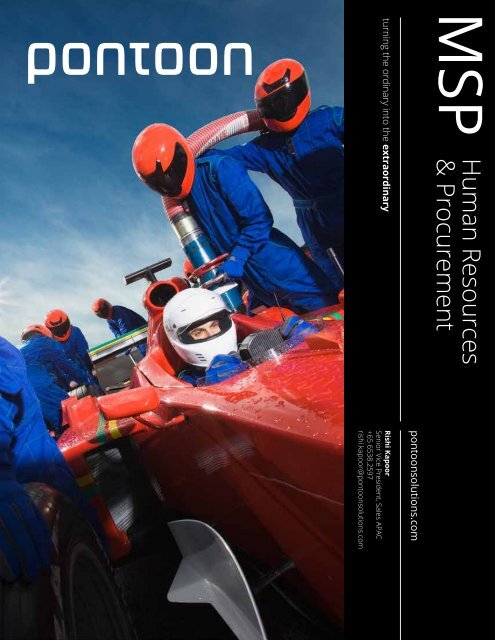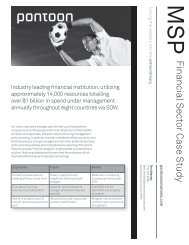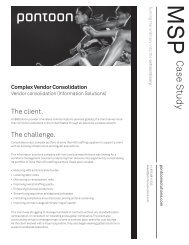Human Resources & Procurement - Pontoon Solutions
Human Resources & Procurement - Pontoon Solutions
Human Resources & Procurement - Pontoon Solutions
Create successful ePaper yourself
Turn your PDF publications into a flip-book with our unique Google optimized e-Paper software.
MSP<strong>Human</strong> <strong>Resources</strong>& <strong>Procurement</strong>turning the ordinary into the extraordinarypontoonsolutions.comRishi KapoorSenior Vice President, Sales APAC+65 6538.2597rishi.kapoor@pontoonsolutions.com
turning the ordinary into the extraordinary<strong>Human</strong> <strong>Resources</strong>& <strong>Procurement</strong>:Working Together To Lead CompaniesForward In Asia Pacific<strong>Pontoon</strong> considers how these two crucial corporate functions can partner effectively.The human resources and procurement functions in many organisations throughout Asia Pacific have become increasinglyentwined primarily due to the fact that the greatest cost to most organisations today is that of human capital. To better managethis important and often complex resource, HR and procurement professionals, more than ever before, need to come togetherto collaborate and to strategise. This can be easier than it sounds when both often have different objectives, priorities and areincentivized in different ways too.If a talent related purchase involves the procuring of MSP or RPO services, the process can be very detailed—often includingthe evaluation of suppliers to be invited to participate, evaluation of request for proposals, screening of shortlisted suppliersand the highly important final selection phase. The work done during these phases must see HR and procurement workingeffectively side-by-side. Similarly, any subsequent contract implementation phase requires strong collaboration between bothHR and procurement stakeholders to ensure effective change management and quick realisation of benefits. <strong>Pontoon</strong> AsiaPacific takes a look at some of the success factors for HR & procurement engagement.The evolution of the “traditional” procurement organisation.Today, the “traditional” procurement organisation has evolved toa “Sourcing and <strong>Procurement</strong> Services Organisation” or “StrategicSourcing Organisation.” This elevated, more strategic function ofprocurement, is now partnering with HR more than ever before.Sourcing professionals typically handle the high-value, high-risk,high-reward, and highly complex types of purchases (mainly focusedon services or specialty items) whereas procurement is more oftenfocused on the operations side (“procure to pay” and “invoice reviewand recovery”). The trend is clear, and likely here to stay, with moreHR services now being purchased with sourcing and procurementdepartments used as an intermediary. To be effective, HR andprocurement teams in organisations across Asia Pacific can increasetheir effectiveness by better understanding how to unlock valuefrom one another by building a relationship that helps generateefficiencies and, ultimately, more effective acquisition of talent andother HR-related services for the companies that they support.A ‘tipping point’ in the HR/procurement relationship.No longer “new” to one another, HR and procurement professionalsare at a stage where their partnership is reaching a certain levelof maturity. HR executives—once used to managing their ownsupply base, developing relationships with vendors and negotiatingtheir own deals—are bringing their procurementcounterparts to the table. Likewise, procurementteams are striving to add value where they can andto strategically support the purchasing process.However, creating value is not as easy as simplybringing HR and procurement teams together andasking them to collaborate. The teams must establisha strong working relationship that starts with afoundation of mutual understanding and respect forone another’s competencies and what they can add toa strategic programme.How can HR and procurement teams bestcollaborate to unlock their combined value?<strong>Pontoon</strong> considers several ways that this is possible:Trust, value and respects one another’s expertiseand skills.<strong>Procurement</strong> and HR teams must engage with oneanother without one side trying to dominate therelationship. Both parties must come to the meetingtable with the understanding that the ultimateobjective is to meet the business goal (e.g., to secure
the right talent and HR services for the company’s needs at the rightprice) and that, in partnership, they will deliver a more valuablesolution. Without this foundation of trust and respect, workingtogether toward that end goal becomes increasingly complex, andcan create detrimental results.Create a consistent and harmonious approach to vendor relationships.Uniting HR and procurement has provided companies with a singleview of their supply base, rather than each HR specialty knowingonly about its own suppliers. This can lead to cost efficiencies due tothe scale and scope of services provided to the overall organisation.However, most organisations that have procurement teams inplace still have a large portfolio of HR services providers to manage.Creating a consistent approach to vendor relationships not onlyhelps the vendors come to expect a certain working relationship witha company, but can also help ensure consistency in managementof that relationship between procurement and HR. A consistentapproach to managing and negotiating with suppliers can eliminategrey areas between HR and procurement during the process, whilealso helping to generate efficiencies throughout the partnership.Speak the same language.Anyone who works amongst peers of the same discipline every dayhas a tendency to speak in their own language. To set clear objectivesand manage processes effectively, HR and procurement teamsmust clearly understand one another and to this end must avoid‘HR/procurement-speak’. In instances where it is unavoidable, it isessential for both parties to explain what terms mean. For example, ifthe procurement team is discussing “aggregation” (combining buyingpower in specific categories within the various business units withina company), it may not be a familiar term or idea for the HR team thatthey are partnering with at that time. It would be important whendiscussing aggregation to be sure everyone in the room understandsthe concept so that they can provide input on where aggregationwould be optimal.Remember soft skills when establishing and developing a partnership.HR/procurement are areas where a hard-skills approach must bebalanced with a soft-skills approach. The procurement team mustCase Study: When HR & <strong>Procurement</strong> Collaboration Supports Vendor Excellenceposition itself as a strategic partner to HR, guidingthe department in the direction it recommends vs.dominating negotiations or vendor relationships. HRmust remember that procurement’s agenda is notnecessarily contradictory to its own, and should beopen to other ideas and recommendations. Havinga candid dialogue and leveraging the expertise,experience and knowledge of both parties, will lead toa more effective solution for the company.Bring services purchasing expertise to the table.HR/procurement is vastly different from materialspurchasing. Buys of services are more often based onrelationships and are not returnable. Bringing a purecost savings mentality to HR/procurement can hindera HR/procurement team relationship from the onset—value, not cost savings, is the ultimate goal. Staffquality and agency service levels are just as importantas generating cost efficiencies as both of theseelements can ultimately deliver hard and soft costsavings associated with productivity enhancements,reduced time to hire, improved engagement andincreased direct referrals etc.Form a partnership and a reliable method ofdelivering value.At the end of the day, clearly defining roles from theonset and throughout the decision-making processis critical to a combined HR/procurement team’ssuccess. Who makes the final decision? Who hasthe lead on the decision timeline? Who is in chargeof the process? Those organisations across the AsiaPacific region that get it right stand to improve intheir efficiency, value, and risk management. Thoseorganisations that allow ineffective procurement/HR relationships to continue are missing a greatopportunity to unlock value in their human capitalstrategy and to move forward in leaps and bounds.A global technology giant successfully brought together its procurement and human resources teams in an attempt toconsolidate contingent labor spend across multiple locations in APAC with the objective of providing visibility on spend, costcontrol and strategic workforce planning. The joint approach of HR and <strong>Procurement</strong> not only ensured vedor neutrality butalso enured the right blend direct sourcing and supply chain management in order to achieve optimal cost efficiency. For theclient, this strategic approach has resulted in 100% fulfilment of all approved contingent resource requests under <strong>Pontoon</strong>management, along with the creation of a ‘self service culture’ for the acquisition of contingent resources - resulting in continuousimprovements in assignment manager satisfaction levels. The self service culture and shift in sourcing mix has also resulted in anadditional cost saving of over 30% in the first year.This client/<strong>Pontoon</strong> relationship is a classic example of how when human resources and procurement successfully collaboratewithin an organisation, vendor relationships can flourish and quickly develop into true partnerships.3MSP





